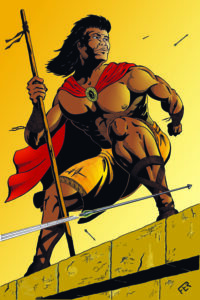To accompany your Come Follow Me study for September 9-15
You will enjoy the following videos related to these chapters:
You will also enjoy the following related commentary from the Institute of Religion Book of Mormon Student Manual:
If you would like a Kahoot game related to this material which you could use for personal study or use with your family or your class, click here: https://create.kahoot.it/share/helaman-13-16/a7baee67-cfb0-4b28-9245-669ba123c0bc . To use it with a group, after clicking on this link, you will need to log into Kahoot, creating a free account if you have not done so previously, then click on the blue “Host Live” button or the gray “Assign” button, depending on how you wish to use the Kahoot. Some of the Kahoot questions may presuppose that the player has read through the suggested answers to the following Points to Ponder and at least has browsed the Institute student manual as well.
Points to Ponder in Helaman 13-16
1. What two passages in Helaman 13-15 tell you that there is something wrong with the following picture depicting Samuel on the wall?

2. For what two reasons is Samuel on the wall rather than down among the people in a more normal meeting?

3. What are the two major reasons the people are so unhappy with him that they are trying to kill him?

4. What are the two reasons that they don’t succeed?

5. What are the two major reasons many Nephites did accept Samuel’s teachings and believe him to be a true prophet?

6. In your opinion, what are the three most significant events Samuel foretells?
7. For what two future events does he specify a time period for their completion?

8. True or False. Four of the following statements are true and three are false, according to the Book of Mormon. Can you separate the true from the false and give a scriptural reference to back up your answers?
a. According to Samuel, when the time comes that the majority in a city or country chooses evil, then that city or country is “ripe for destruction.”
b. Until the time a person dies there is always an opportunity for him to receive forgiveness through genuine humility and sincere repentance.
c. Samuel taught that all who believe on the name of Christ will be saved in the celestial kingdom.
d. The atonement of Christ redeems all men from both physical and spiritual death.
e. All mankind will eventually return to the presence of the Lord.
f. Even though all men are God’s children, according to Samuel he loves some of them and hates others.
g. The doubters in 16:17-19 can be partially excused for their unbelief since Samuel had never promised them that Christ would appear among them in the Americas.
9. How does 14:20 help date Christ’s death?
10. What, in your opinion, are the most important lessons or doctrinal teachings found in these chapters which need additional emphasis?
Possible Answers to Points to Ponder in Helaman 13-16
1. What two passages in Helaman 13-15 tell you that there is something wrong with the above picture depicting Samuel on the wall?
a. (13:4) He apparently got up on the wall from outside the city, but there would have been no stairway on the other side and no easy way to get up that high without one.
b. (16:7) He jumped off the wall, but if it were as high as shown in the painting, he would have killed himself.
2. For what two reasons is Samuel on the wall rather than down among the people in a more normal meeting?
a. They wouldn’t let him into the city. (13:4)
b. More people could hear him up there. (14:11)
3. What are the two major reasons the people are so unhappy with him that they are trying to kill him?
a. He is a Lamanite. The wicked Nephites are guilty of racial prejudice, among other things. (14:10)
b. He is criticizing their way of life. (14:10; 13:26)
4. What are the two reasons that they don’t succeed?
a. Divine protection.
b. He leaves.
5. What are the two major reasons many Nephites did accept Samuel’s teachings and believe him to be a true prophet?
a. 16:1 (plus 2 Ne. 33:1) The Spirit testifies that his words are true.
b. 16:3 The miracle of not being able to hit him.
6. In your opinion, what are the three most significant events Samuel foretells?
For me, they would be:
a. Christ’s death and resurrection
b. Nephite destruction (13:5)
c. Restoration of the Lamanites (15:12-16)
7. For what two future events does he specify a time period for their completion?
a. 13:5-6 Great destruction will occur within 400 years.
b. 14:2 Christ will come after five more years.
8. True or False. Four of the following statements are true and three are false, according to the Book of Mormon. Can you separate the true from the false and give a scriptural reference to back up your answers?
a. According to Samuel, when the time comes that the majority in a city or country chooses evil, then that city or country is “ripe for destruction.” [False 13:14. They are not fully ripe for destruction until the wicked majority casts out the righteous minority.]
b. Until the time a person dies there is always an opportunity for him to receive forgiveness through genuine humility and sincere repentance. [False. 13:38. Just as it’s possible to make one’s “calling and election sure,” so does it appear possible to make one’s damnation sure.]
c. Samuel taught that all who believe on the name of Christ will be saved in the celestial kingdom. [True. 14:8, 13. As he explains, if one really believes, he will repent of his sins.]
d. The atonement of Christ redeems all men from both physical and spiritual death. [True. 14:16-17. But the wicked will then die a second spiritual death and be cut off again from the presence of the Lord.]
e. All mankind will eventually return to the presence of the Lord. [True. 14:17. But, as indicated above, for some it will be only temporary.]
f. Even though all men are God’s children, according to Samuel he loves some of them and hates others. [True. 15:3-4. Presumably, Samuel really meant that He hates the deeds of the wicked.]
g. The doubters in 16:17-19 can be partially excused for their unbelief since Samuel had never promised them that Christ would appear among them in the Americas. [False. It had been repeatedly taught that Christ would appear among the Nephites. See 1 Ne. 12:6. 2 Ne. 32:6. Alma 16:20 Alma 45:10.]
9. How does 14:20 help date Christ’s death?
See an interesting article on the subject at: https://knowhy.bookofmormoncentral.org/knowhy/how-does-the-book-of-mormon-help-date-christs-death and enjoy a related video at:
10. What, in your opinion, are the most important lessons or doctrinal teachings found in these chapters that in your opinion need additional emphasis?
Your choice. For me they might be:
a. The “glad tidings” of the coming of Christ and His atonement for us all. (13:7ff)
b. Seeking for happiness in iniquity is contrary to the nature of that righteousness which is in our great and Eternal Head. (13:38)
c. Men are free to act for themselves. All bring upon themselves their own condemnation. (14:29-30)
d. A righteous minority can forestall destruction. (13:12-14)
e. We should “hide up our treasures unto the Lord.” (13:19)
f. Occult phenomena increase as wickedness increases. (13:34-37)
g. The “unwearied diligence” of the Lamanites is an example for all of us. (15:6, 10)
h. It is important to always thank the Lord for His blessings to us. (13:22)
i. In teaching or preaching, we should speak “whatsoever things should come” into our hearts. (13:3)
j. The Lord provides sufficient evidence of the truthfulness of the gospel that those who do not believe can be justly condemned for their willful unbelief. (13:28-29)
k. The Lord chastens us because He loves us. (15:3)
l. “Reason” can lead to false conclusions if you start with false premises. (16:17-18)
